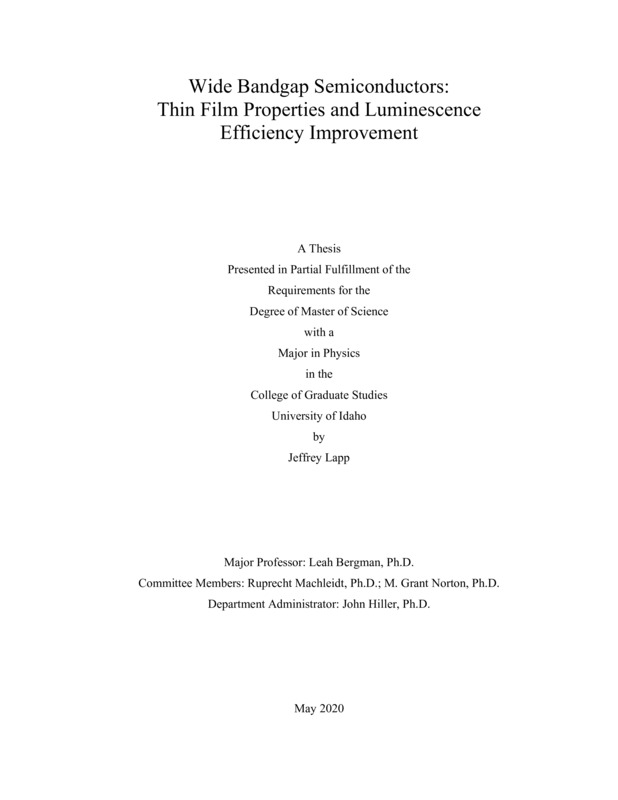Wide Bandgap Semiconductors: Thin Film Properties and Luminescence Efficiency Improvement
Lapp, Jeffrey. (2020-05). Wide Bandgap Semiconductors: Thin Film Properties and Luminescence Efficiency Improvement. Theses and Dissertations Collection, University of Idaho Library Digital Collections. https://www.lib.uidaho.edu/digital/etd/items/lapp_idaho_0089n_11821.html
- Title:
- Wide Bandgap Semiconductors: Thin Film Properties and Luminescence Efficiency Improvement
- Author:
- Lapp, Jeffrey
- Date:
- 2020-05
- Keywords:
- gallium oxide luminescence semiconductor zinc oxide
- Program:
- Physics
- Subject Category:
- Applied physics; Materials Science
- Abstract:
-
Modern technological applications require high performance materials that possess novel properties to efficiently operate in a wide range of conditions. In this work, the performance enhancement of ZnO thin films was studied, while basic research on the optical properties of Ga2O3 thin films was performed.
Two approaches for the enhancement of the UV band edge photoluminescence (PL) in sputtered ZnO films were studied. One that used surface coating, and another that employed annealing in a non-oxidizing environment. It was found that by combining both methods, annealing at an optimal temperature followed by the deposition of a coating, a significant enhancement of the luminescence can be achieved. Three types of coatings were investigated, Al2O3, SiO2, and MgO. It was found that MgO, due to its strong bond energy, is an effective coating material for the passivation of the surfaces of the ZnO films. The UV-PL intensity of MgO coated ZnO was found to increase by a factor of ~ 52 relative to an uncoated film. The effectiveness of the coating layer was discussed in terms of competing mechanisms to surface passivation, such as the adsorption of OH-groups, which can act as surface traps and diminish PL intensity. Moreover, annealing at 900 C prior to the deposition of the coating was found to be an important step in realizing the optimal performance of the coating material. A visible luminescence study indicated that the annealing process diminishes the presence of native defects that can act as bulk-like nonradiative centers that impact the UV luminescence.
An initial study of gallium oxide (Ga2O3) thin films was performed to determine the optical properties of this ultra-wide bandgap semiconductor. β-Ga2O3 thin films were grown via RF sputtering in two growth environments with different oxygen concentrations. Prior to characterization, a post growth annealing step was accomplished. An oxygen-rich growth environment resulted in highly defective films that resulted in broad, intense photoluminescent (PL) emissions accompanied by a weak deep ultraviolet peak. Adjustment to a lower oxygen content during growth resulted in higher quality films that display five resolved PL peaks in the UV range, including band edge emissions of ~ 4.85 eV that match the band edge values obtained via transmission spectroscopy. Additional peaks at ~ 3.14 eV and ~ 3.56 eV were attributed to donor-acceptor recombination and self-trapped hole emissions, respectively. Designation of the self-trapped hole emissions at ~ 3.56 eV was verified by its absence in the PL spectra when sub-bandgap 3.8 eV excitation is used. Post-growth annealing in an oxygen environment instead of in air resulted in a blue shift of the PL spectra of ~ 120 meV and decreased the intensity of the ~3.56 eV STH related peak. These results indicate that the defect concentration in these films is highly sensitive to their oxygen content, which makes this material ideal for use in oxygen sensing devices.
- Description:
- masters, M.S., Physics -- University of Idaho - College of Graduate Studies, 2020-05
- Major Professor:
- Bergman, Leah
- Committee:
- Machleidt, Ruprecht; Norton, M. Grant
- Defense Date:
- 2020-05
- Identifier:
- Lapp_idaho_0089N_11821
- Type:
- Text
- Format Original:
- Format:
- application/pdf
- Rights:
- In Copyright - Educational Use Permitted. For more information, please contact University of Idaho Library Special Collections and Archives Department at libspec@uidaho.edu.
- Standardized Rights:
- http://rightsstatements.org/vocab/InC-EDU/1.0/

